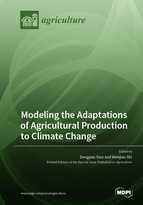Modeling the Adaptations of Agricultural Production to Climate Change
A special issue of Agriculture (ISSN 2077-0472). This special issue belongs to the section "Ecosystem, Environment and Climate Change in Agriculture".
Deadline for manuscript submissions: closed (20 January 2023) | Viewed by 46965
Special Issue Editors
Interests: crop model; phenology; climate change; agricultural water management; agricultural ecology
Special Issues, Collections and Topics in MDPI journals
Interests: climate change; food security; irrigation; modelling; crop production
Special Issues, Collections and Topics in MDPI journals
Special Issue Information
Dear Colleagues,
Climate change and its impacts on agricultural production and food security are a significant source of public concern around the world. In order to reduce the negative impact of climate change on agriculture, maintain crop production levels, and even discover opportunities in agricultural intensification, researchers have made great efforts to assess changes in agricultural climate resources and develop adaptation measures in different growing areas of the world under climate change. Modeling is a key tool for exploring the impact of climate change on agriculture and proposing adaptation strategies. Currently, the two main fields where further progress is required include a more mechanistic understanding of climate impacts and management options for adaptation and mitigation, and a focus on cropping systems and integrative multiscale assessments instead of single season and crops. Therefore, establishing closer links between experiments and statistical and/or eco-physiological crop models may not only facilitate the necessary methodological advances but also achieve the above goals.
This Special Issue focuses on the quantitative assessment of the impact of climate change on agricultural production based on multi-source model simulation and reveals the role and mechanism of improved management measures in adapting to climate change. It is expected that insights derived from this Special Issue will be helpful for relevant decision-makers in the areas of agricultural adaptation and food security.
Prof. Dr. Dengpan Xiao
Prof. Dr. Wenjiao Shi
Guest Editors
Manuscript Submission Information
Manuscripts should be submitted online at www.mdpi.com by registering and logging in to this website. Once you are registered, click here to go to the submission form. Manuscripts can be submitted until the deadline. All submissions that pass pre-check are peer-reviewed. Accepted papers will be published continuously in the journal (as soon as accepted) and will be listed together on the special issue website. Research articles, review articles as well as short communications are invited. For planned papers, a title and short abstract (about 100 words) can be sent to the Editorial Office for announcement on this website.
Submitted manuscripts should not have been published previously, nor be under consideration for publication elsewhere (except conference proceedings papers). All manuscripts are thoroughly refereed through a single-blind peer-review process. A guide for authors and other relevant information for submission of manuscripts is available on the Instructions for Authors page. Agriculture is an international peer-reviewed open access monthly journal published by MDPI.
Please visit the Instructions for Authors page before submitting a manuscript. The Article Processing Charge (APC) for publication in this open access journal is 2600 CHF (Swiss Francs). Submitted papers should be well formatted and use good English. Authors may use MDPI's English editing service prior to publication or during author revisions.
Keywords
- crop model
- phenology
- yield
- water use
- cultivar
- fertilizer
- sowing date
- irrigation
- CO2 concentration
- extreme climate
- future climate scenarios
- temperature







